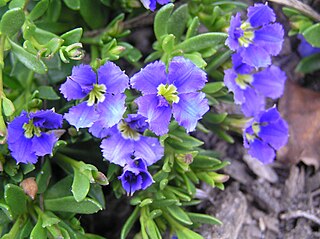
In physics, the kinetic energy of an object is the energy that it possesses due to its motion. It is defined as the work needed to accelerate a body of a given mass from rest to its stated velocity. Having gained this energy during its acceleration, the body maintains this kinetic energy unless its speed changes. The same amount of work is done by the body when decelerating from its current speed to a state of rest.
In linear algebra, an eigenvector or characteristic vector of a linear transformation is a nonzero vector that changes at most by a scalar factor when that linear transformation is applied to it. The corresponding eigenvalue, often denoted by , is the factor by which the eigenvector is scaled.
Blue squill is a common name for several plants and may refer to:

Maranoa Gardens began in the early 1890s, when Mr John Middleton Watson purchased 1.4 hectares in Balwyn, a suburb of Melbourne, Australia, for a private garden. He planted many Australian and New Zealand native trees and shrubs and the area was maintained purely as a garden. He named the gardens Maranoa after a river in Queensland, from native words meaning flowing, alive or running.

Goodeniaceae is a family of flowering plants in the order Asterales. It contains about 404 species in twelve genera. The family is distributed mostly in Australia, except for the genus Scaevola, which is pantropical. Its species are found across most of Australia, being especially common in arid and semi-arid climates.

Dampiera is a genus of plants in the family Goodeniaceae which are endemic to Australia occurring in all states. They are herbaceous plants or small shrubs which have blue or purple flowers with yellow centres. The genus is named for William Dampier, an English sea captain and scientific observer. Dampiera diversifolia is sometimes grown in gardens as an ornamental.

West Mount Barren is part of the Fitzgerald River National Park located between Bremer Bay and Hopetoun on the south coast of Western Australia the coordinates of the summit of West Mount Barren are 34°12′59″S119°25′58″E.

Dampiera linearis, commonly known as common dampiera or wedge-leaved dampiera, is an erect perennial herb in the family Goodeniaceae. The species, which is endemic to the south-west of Western Australia, grows to between 15 and 60 cm high, with its blue to purple flowers appearing between July and December. It adapts readily to cultivation, particularly containers such as hanging baskets.

Dampiera stricta is an erect perennial subshrub in the family Goodeniaceae. The species, which is native to Australia, grows to between 0.2 and 0.6 metres in height. It produces blue flowers between August and January in its native range. It occurs in the states of Tasmania, Victoria, New South Wales and Queensland.

Dampiera dysantha, the shrubby dampiera, is an undershrub in the family Goodeniaceae. The species grows to 70 cm high The flowers are blue, or occasionally white to lilac and are covered on the outside with grey and rusty hairs. These generally appear between September and October in its native range.

Dampiera purpurea, commonly known as the mountain- or purple dampiera, is a subshrub in the family Goodeniaceae native to Victoria, New South Wales and Queensland in eastern Australia. Its blue-purple flowers appear in spring and early summer, and it is pollinated by insects such as butterflies and bees. Adapting readily to cultivation, Dampiera purpurea is grown as a garden plant in Australia.

Dampiera diversifolia is a subshrub in the family Goodeniaceae from the southwest of Western Australia.

Dampiera hederacea, commonly known as the karri dampiera, is an erect perennial herb in the family Goodeniaceae. The species, which is endemic to the south-west of Western Australia, is a low spreading shrub which reaches 40 cm (16 in) across. It produces blue flowers between August and January in its native range.
Dampiera teres, commonly known as the terete-leaved dampiera, is an erect perennial herb in the family Goodeniaceae. The species, which is endemic to Western Australia north of Perth.
Dampiera altissima, commonly known as the tall dampiera, is an erect perennial herb in the family Goodeniaceae. The species, which is endemic to Western Australia north of Perth.
Dampiera wellsiana is a perennial herb in the family Goodeniaceae. The species, which is endemic to Western Australia north of Perth.

Dampiera candicans is a plant in the family Goodeniaceae, native to Western Australia and the Northern Territory.

Dampiera dentata is a plant in the family Goodeniaceae, native to Western Australia and the Northern Territory.

Dampiera alata is a plant in the family Goodeniaceae, native to Western Australia.












